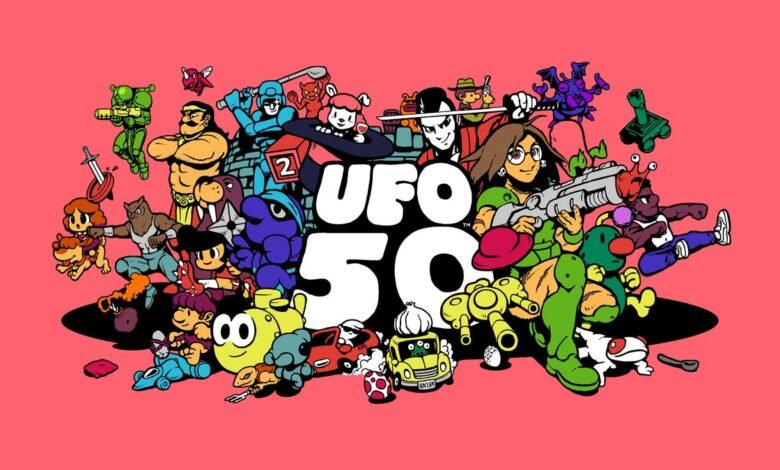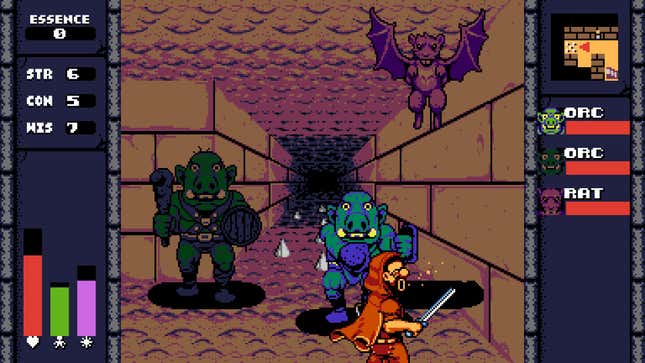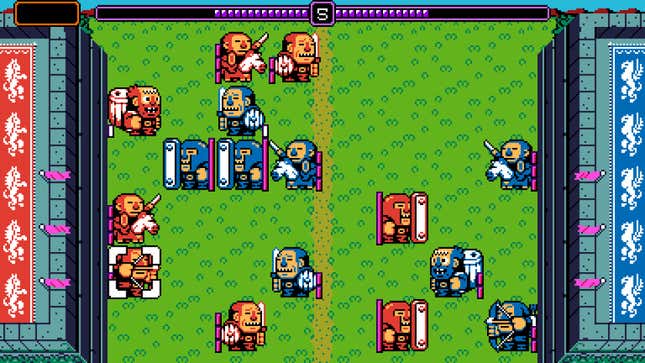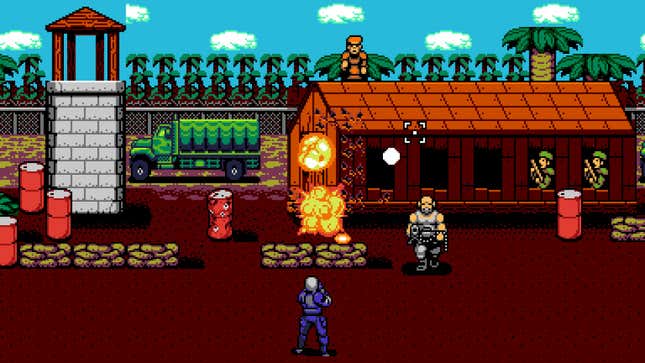
Efforts to preserve, spotlight, and celebrate important games of the past have been gaining steam in recent years. Consider, for instance, Digital Eclipse’s Atari 50, a compilation of games from across that company’s history that provides wonderful context in the form of interviews and archival materials, illuminating their colossal impact on gaming. Now, we have another such compilation: UF0 50, a collection of 50 games from UFO Soft, the business-software-maker-turned-game-developer that, across the 1980s, was responsible for dozens of gems which simultaneously reflected the larger gaming trends of the time, while also innovating and pushing the medium forward in their own right. There’s just one small but crucial detail here, however, that sets UFO 50 apart from any other such compilations: UFO Soft never actually existed.
That’s right, UFO 50 is, for lack of a better term, a “fictional” game compilation, though the games are very real. Here, in their entirety, are 50 games–not minigames, mind you, not little playable demos, but full-length, complete gaming experiences–from a company that never existed. Developers Derek Yu (Spelunky), Jon Perry (Air Land & Sea), and musician Eirik Suhrke (Hotline Miami) spearheaded the project, but they and the other devs actually responsible for the games here are fully committed to the bit. If you beat a game here, it’s the fictional devs of UFO Soft whose names you’ll see on the staff roll. Instead, Yu and the others responsible are listed in the compilation’s opening as “the UFO 50 Recovery Team.” In this sequence, we see them digging an old gaming computer out of someone’s storage unit and beginning the process of recovering these games for preservation in this collection. “Whenever possible,” we are told, “the integrity of the original software was preserved.”
The 50 games here present a picture of a company that, in 1982, took its tentative first step into game development with the challenging and mysterious adventure game, Barbuta (“Developed secretly on company time, it almost got Thorson Petter fired,” an in-game factoid tells us), and that, by 1989, was producing games like the vibrant, multi-genre Cyber Owls, “launched alongside an original comic book series.” At every step, UFO Soft was both responding to current gaming trends and establishing its own identity, producing games that tried to capitalize on popular new genres and tendencies in game design while also bearing their own distinctive authorship.
And this, in my view, is essential to what makes UFO 50 so fascinating. Often, modern retro games wear their references a little too proudly, containing winking references to games of the past as if to say to you, “We know you like Classic Game X! We like Classic Game X, too! See, we’re doing that thing you liked back when that game did it!” There’s none of that here in UFO 50. This game believably creates a kind of pocket dimension in which UFO Soft actually existed, creating games that capitalize on the rapidly improving game hardware of the 1980s but that aren’t beholden to what everyone else was doing.
Barbuta, for instance, feels roughly on par with something you might see on the MSX in the early 80s, while Cyber Owls feels akin to an elaborate blockbuster that might have arrived on the NES in 1989, when developers were figuring out how to make the most of that console’s power. (Similarly, it doesn’t cheat with trends or genres, either. UFO Soft makes a beat-em-up, for instance, but not before beat-em-ups exist.) But this isn’t, thank goodness, a compilation in which you’ll find one-to-one clones of the era’s hits. There isn’t UFO Soft’s take on Super Mario Bros. here, though you’ll certainly see elements from games you know and love, which makes it feel as if UFO Soft was around at that time and in conversation with what the rest of the game development landscape was doing. Sometimes I’d dive into a game and say, “Oh, cool, this feels like it’s riffing on Blaster Master,” or “Okay, I can definitely see elements of Space Taxi here,” but these games also always felt distinctive, as if made by people with their own ideas, who wanted to make their own contribution to the medium.

To give you a quick sense of the breadth of what’s on offer here, I’m going to highlight five of the games that have stood out to me most in my time with UFO 50. (Remember, there are 50 games here. I’ve played about ten hours of UFO 50 in all, so to say that I’ve barely scratched the surface of what’s available here is an understatement.) The one that’s grabbed me the most right out of the gate is Valbrace, a tough action-RPG released, the game’s fiction would have it, in 1988. I haven’t made it very far yet, but its fusion of twitchy combat and first-person dungeon crawling is immediately appealing, and I’m determined to level up my intrepid adventurer and find out what awaits in the dungeon’s lower levels. It also reminded me of how, in the 1980s, it was always exciting if I equipped some new weapon or armor on a game character and their sprite changed. It’s a little thing but it went a long way toward making the visuals feel more immersive and responsive to me as a player. Valbrace has that, and I felt that same little thrill I felt as a kid when I spotted it for the first time.
Next, there’s Rail Heist, a fascinating hybrid of real-time and turn-based gameplay with destructible environments in which each stage is a kind of puzzle. Playing as a member of a train-robbing crew in the Old West, you must figure out how to get the money on the locomotive out from under the noses of the lawmen guarding it. It’s simultaneously strategic and kinetic, a real blast.

Attactics is a fast-paced real-time tactics game for people like me who often avoid tactics games. Units from two opposing castles march toward each other automatically, but you can frantically grab your own units and slide them into advantageous formations to better withstand and conquer the enemy onslaught.
Porgy is a gorgeous undersea adventure in which you pilot an adorable little submarine (with eyes!) to find upgrades and solve a mystery. The world is filled with both dangers (giant shark attacks!) and secrets just waiting to be discovered.

Finally, the aforementioned Cyber Owls is a fitting game to close out UFO 50’s chronology. Ostensibly released in 1989 and the “final” game in this compilation, Cyber Owls shows the developers at UFO Soft pulling out all the stops to make an elaborate multi-genre hit. The rogue commando group H.A.W.K. has acquired a doomsday weapon, putting the whole world in danger, and naturally, the president calls upon the only heroes who are up to the task of thwarting their deadly plans: the Cyber Owls. Each of the four missions your cadre of elite avian agents must undertake is wholly distinct: one’s a beat-em-up, one’s a Cabal-style shooter, one’s a Metal Gear-esque stealth mission, and one’s a side-scrolling vehicular shmup. What really makes it all work for me, though, is the way that it actually feels like it’s based on a Saturday morning cartoon or comic book. As you progress, you encounter an assortment of villains who easily could have belonged to the rogue’s gallery on a show that fused Teenage Mutant Ninja Turtles with G.I. Joe, and it feels like the devs gave some real thought to fleshing out this fictional late-80s IP.
And yet, that very brief overview of five of the included games here–just one tenth of the entire library–is wholly inadequate at trying to convey the experience of actually playing UFO 50. For one, there are so many other types of experiences here. There’s a game with Smash T.V.-style arena shooting. There’s a first-person horror adventure game that plays similarly to Shadowgate or Deja Vu. There’s a Japanese-style RPG set in a Wild West world. There’s a strategic deckbuilder of sorts in which you try to have the right assortment of people in your Rolodex to ensure your parties are a rousing success. There’s a wonderfully strange puzzle platformer in which you deliberately sacrifice your character’s lives to create a path for the lives that follow. And so much more. The real point of UFO 50, if it can be said to have one, lies not in any individual game, as great as some of them are, but in the variety and richness of what they offer when collected here.
Playing UFO 50 feels something like being dropped off at your grandparents’ house as a kid and finding that they have an old console you’ve never heard of and a library of games you know nothing about. You’re probably not going to love all of them, but that’s actually good, I would argue. UFO 50 would probably be a much safer and more limited collection if it felt calibrated for maximum mainstream appeal; part of what makes it so great is that, while a number of games here may not quite click with you, they will all probably really click with someone, in a way games only can when they take chances and feel like the work of individuals rather than a committee. There’s joy and excitement in the act of exploration and discovery, in encountering something inscrutable and pushing up against it until it starts to click for you. (Pro tip: If you find a game particularly hard to penetrate, just let it sit on the title screen for a minute. There’s a chance that, like many actual games of the era, it will start a demo sequence that at least offers some clue as to how to approach it.)
And while some of these games might have been minor hits today on Steam if they were released independently, UFO 50 is so much more than the sum of its parts. Hopping around from game to game here, playing them alongside each other and in the context of each other, what emerges is not just a collection of fun, inventive, and incredibly varied games that could have been made in the 1980s, but weren’t. This is an ode to innovation and game design itself, a celebration of those visionaries who, in gaming’s early days, had fresh, original ideas and pushed a burgeoning art form to its limits in order to realize them. This is a tribute to the people behind one of the most exciting eras in game history, a time when new genres and new concepts were appearing all the time. And, in that way, it also feels to me like a statement about what matters most in game design. It’s not the biggest budgets or the most polish. It’s creativity and experimentation, a willingness to try new things and keep pushing a young medium forward. With any luck, we’re just getting started.
.
Source link






